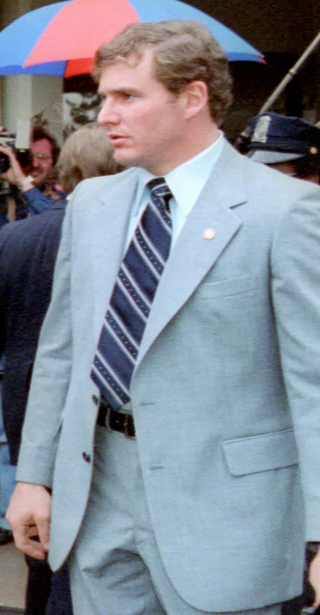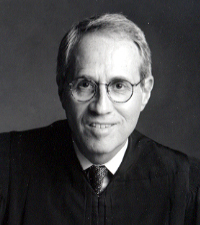
Lead(II) azide Pb(N3)2 is an inorganic compound. More so than other azides, it is explosive. It is used in detonators to initiate secondary explosives. In a commercially usable form, it is a white to buff powder.

James Scott Brady was an American public official who served as assistant to the U.S. president and the 17th White House Press Secretary, serving under President Ronald Reagan. In 1981, John Hinckley Jr. shot and wounded Brady during Hinckley’s attempted assassination of Ronald Reagan, which occurred two months and ten days after Reagan's inauguration.

The Brady Handgun Violence Prevention Act, often referred to as the Brady Act, the Brady Bill, or the Brady Handgun Bill is an Act of the United States Congress that mandated federal background checks on firearm purchasers in the United States. It also imposed a five-day waiting period on purchases until the National Instant Criminal Background Check System (NICS) was implemented in 1998. Introduced by U.S. representative Chuck Schumer of New York, the Brady Act was a landmark legislative enactment during the Clinton administration. The act was appended to the end of Section 922 of title 18, United States Code. The intention of the act was to prevent persons with previous serious convictions from purchasing firearms.

John Warnock Hinckley Jr. is an American man who attempted to assassinate U.S. President Ronald Reagan as he left the Hilton Hotel in Washington, D.C., on March 30, 1981, two months after Reagan's first inauguration. Using a revolver, Hinckley wounded Reagan, the police officer Thomas Delahanty, the Secret Service agent Tim McCarthy and the White House Press Secretary, James Brady. Brady was left disabled and eventually died from his injuries.

Roy Herman Kellerman was a U.S. Secret Service senior agent who was assigned to protect United States President John F. Kennedy when he was assassinated on November 22, 1963, in Dallas. In his reports, later testimony and interviews, Kellerman outlines in detail his role in the immediate aftermath of the assassination.

Timothy J. McCarthy is an American former police officer and special agent in the United States Secret Service. McCarthy is best known for defending President Ronald Reagan during the assassination attempt on Reagan's life on Monday, March 30, 1981, in Washington, D.C.

Frank James Reynolds was an American television journalist for CBS and ABC News.

The Metropolitan Police Department of the District of Columbia (MPDC), more commonly known as the Metropolitan Police Department (MPD), the DC Police, and, colloquially, the DCPD, is the primary law enforcement agency for the District of Columbia, in the United States. With approximately 3,400 officers and 600 civilian staff, it is the sixth-largest municipal police department in the United States. The department serves an area of 68 square miles (180 km2) and a population of over 700,000 people. Established on August 6, 1861, the MPD is one of the oldest police departments in the United States. The MPD headquarters is at the Henry J. Daly Building, located on Indiana Avenue in Judiciary Square across the street from the District of Columbia Court of Appeals and the Superior Court of the District of Columbia. The department's mission is to "safeguard the District of Columbia and protect its residents and visitors with the highest regard for the sanctity of human life". The MPD's regulations are compiled in title 5, chapter 1 of the District of Columbia Code.

On March 30, 1981, President of the United States Ronald Reagan was shot and wounded by John Hinckley Jr. in Washington, D.C., as he was returning to his limousine after a speaking engagement at the Washington Hilton. Hinckley believed the attack would impress actress Jodie Foster, with whom he had developed an erotomanic obsession.

Eugene Vincent Atkinson was an American politician who, from 1979 to 1983, served two-terms as a member of the U.S. House of Representatives from Pennsylvania.

Leslie William Coffelt was an officer of the White House Police, a branch of the Secret Service, who was killed while successfully defending U.S. President Harry S. Truman against an attempted assassination on November 1, 1950, at Blair House, where the president was living during renovations at the White House.

The autopsy of John F. Kennedy, the 35th president of the United States, was performed at the Bethesda Naval Hospital in Bethesda, Maryland. The autopsy began at about 8 p.m. Eastern Standard Time (EST) on November 22, 1963—the day of Kennedy's assassination—and ended in the early morning of November 23, 1963. The choice of autopsy hospital in the Washington, D.C. area was made by his widow, First Lady Jacqueline Kennedy, who chose the Bethesda as President Kennedy had been a naval officer during World War II.

An assassination attempt on U.S. President Harry S. Truman occurred on November 1, 1950. It was carried out by militant Puerto Rican pro-independence activists Oscar Collazo and Griselio Torresola while President Harry S. Truman resided at Blair House during the renovation of the White House. Both men were stopped before gaining entry to the house. Torresola mortally wounded White House Police officer Leslie Coffelt, who killed him in return fire. Secret Service agents wounded Collazo. Truman was upstairs in the house and not harmed.

Röhm Gesellschaft, often referred to as RG, is a German brand of firearms and related shooting equipment. RG developed as a diversification of Röhm GmbH in the 1950s. After 1968, RG Industries was established as a US division in Miami and operated until 1986. In 2010, the RG brand was acquired by Umarex GmbH & Co. KG. Röhm's RG-14 handgun, used in an assassination attempt on then US President Ronald Reagan, was referred to in 1981 as a Saturday night special, a cheaply manufactured firearm of perceived low quality, believed at the time to be favored by criminals.

Paul Lawrence Friedman is a senior United States district judge of the United States District Court for the District of Columbia. He serves as secretary of the American Law Institute.

Jerry S. Parr was a United States Secret Service special agent who is best known for defending President Ronald Reagan during the attempt on the president's life on March 30, 1981, in Washington, D.C. Parr pushed Reagan into the presidential limousine and made the critical decision to divert the presidential motorcade to George Washington University Hospital instead of returning to the White House. He was honored for his actions that day with U.S. Congress commendations, and is widely credited with helping to save the president's life.
William T. Carpenter is an American psychiatrist, a pioneer in the fields of psychiatry and pharmacology who served as an expert witness in the John W. Hinckley trial for the attempted assassination of U.S. President Ronald Reagan. His primary professional interest is in severe mental illness, especially schizophrenia, to the prevention and treatment of which he has made significant contributions in psychopathology, assessment methodology, testing of new treatments, and research ethics.
Without Warning: The James Brady Story is a 1991 American television film directed by Michael Toshiyuki Uno and starring Beau Bridges as James Brady, the White House Press Secretary who was shot during the attempted assassination of President Ronald Reagan in 1981. The film is based on Mollie Dickenson's 1987 biography about Brady titled Thumbs Up.

















